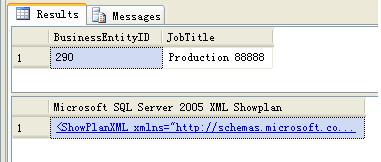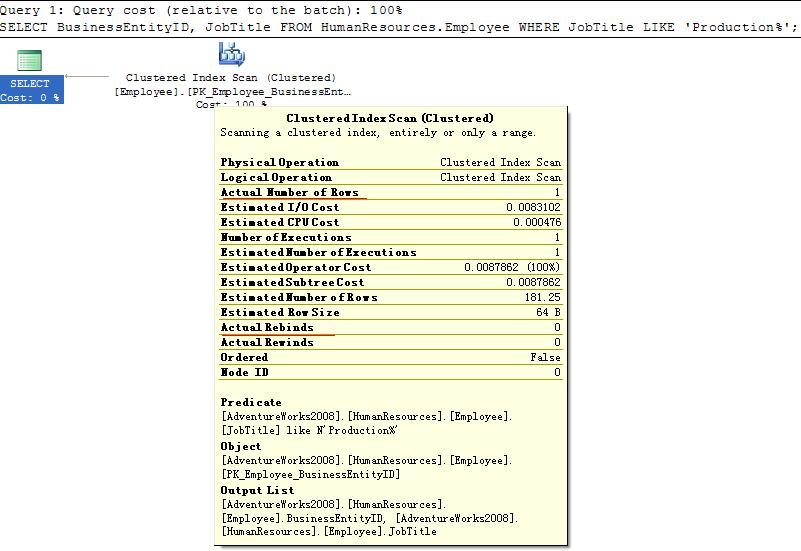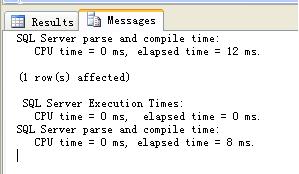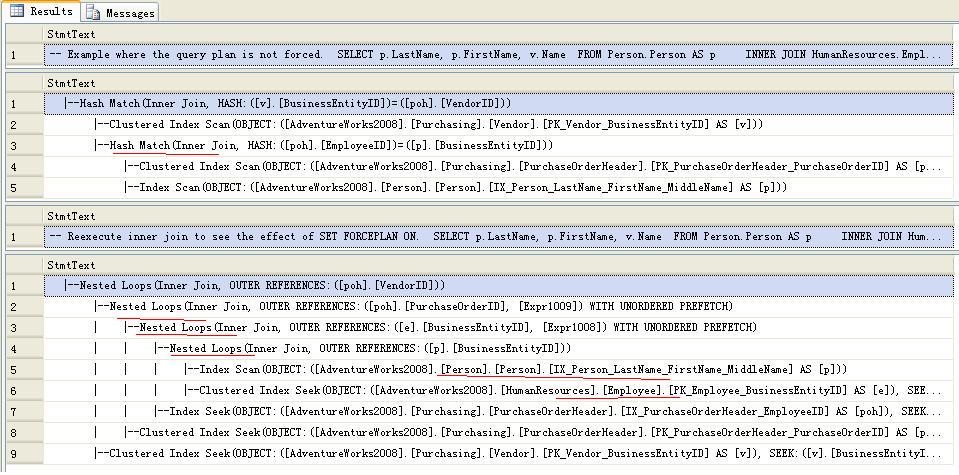SET Statements for SQLServer
SET SHOWPLAN_ALL { ON | OFF }
- It will not execute the TSQL statements.
- It cannot be specified inside a stored procedure,must be the only statements in a batch.
- Returns information as a set of rows that form a hierarchical tree representing the steps taken by the SQL Server query processor as it executes each statement. Each statement reflected in the output contains a single row with the text of the statement, followed by several rows with the details of the execution steps.
SET SHOWPLAN_ALL ON;
GO
SELECT BusinessEntityID, JobTitle
FROM HumanResources.Employee
WHERE JobTitle LIKE 'Production%';
GO
SET SHOWPLAN_ALL OFF;
GO

All the information in the resultset are estimated, no any actual statistics information.
SET SHOWPLAN_XML { ON | OFF }
- It will not execute the TSQL statements.
- It will return detailed information about how the statements are going to be executed in XML.
SET SHOWPLAN_XML ON;
GO
SELECT BusinessEntityID, JobTitle
FROM HumanResources.Employee
WHERE JobTitle LIKE 'Production%';
GO
SET SHOWPLAN_XML OFF;
GO


SET SHOWPLAN_TEXT { ON | OFF }
- It will not execute the TSQL statements.
- It cannot be specified inside a stored procedure,must be the only statements in a batch.
- Returns information as a set of rows that form a hierarchical tree representing the steps taken by the SQL Server query processor as it executes each statement. Each statement reflected in the output contains a single row with the text of the statement, followed by several rows with the details of the execution steps. The table shows the column that the output contains.
- SET SHOWPLAN_TEXT is intended to return readable output for Microsoft Win32 command prompt applications such as the osql utility. SET SHOWPLAN_ALL returns more detailed output intended to be used with programs designed to handle its output.
SET SHOWPLAN_TEXT ON;
GO
SELECT BusinessEntityID, JobTitle
FROM HumanResources.Employee
WHERE JobTitle LIKE 'Production%';
GO
SET SHOWPLAN_TEXT OFF;
GO

SET STATISTICS PROFILE { ON | OFF }
- It will execute the TSQL statements.
- Returns information as a set of rows that form a hierarchical tree representing the steps taken by the SQL Server query processor as it executes each statement. Each statement reflected in the output contains a single row with the text of the statement, followed by several rows with the details of the execution steps.
- While compare with SHOWPLAN_ALL, it has two additional column Rows,Executes.
SET statistics profile ON;
GO
SELECT BusinessEntityID, JobTitle
FROM HumanResources.Employee
WHERE JobTitle LIKE 'Production%';
GO
SET statistics profile OFF;
GO

SET STATISTICS XML { ON | OFF }
- It will execute the TSQL statements.
- It will generate detailed information about how the statements were executed in XML.
- SET STATISTICS XML need not be the only statement in a batch.
- SET STATISTICS XML returns output as nvarchar(max) for applications, such as the sqlcmd utility, where the XML output is subsequently used by other tools to display and process the query plan information. The xml comply with below xsd file \Microsoft SQL Server\100\Tools\Binn\schemas\sqlserver\2004\07\showplan\showplanxml.xsd
- SET STATISTICS PROFILE and SET STATISTICS XML are counterparts of each other. The former produces textual output; the latter produces XML output. In future versions of SQL Server, new query execution plan information will only be displayed through the SET STATISTICS XML statement, not the SET STATISTICS PROFILE statement.
- If Include Actual Execution Plan is selected in SQL Server Management Studio, this SET option does not produce XML Showplan output. Clear the Include Actual Execution Plan button before using this SET option.
SET STATISTICS XML ON;
GO
SELECT BusinessEntityID, JobTitle
FROM HumanResources.Employee
WHERE JobTitle LIKE 'Production%';
GO
SET STATISTICS XML OFF;
GO


SET STATISTICS TIME { ON | OFF }
- When SET STATISTICS TIME is ON, the time statistics for a statement are displayed. When OFF, the time statistics are not displayed.
- The setting of SET STATISTICS TIME is set at execute or run time and not at parse time.
- Microsoft SQL Server is unable to provide accurate statistics in fiber mode, which is activated when you enable the lightweight pooling configuration option.
- The cpu column in the sysprocesses table is only updated when a query executes with SET STATISTICS TIME ON. When SET STATISTICS TIME is OFF, 0 is returned.
- ON and OFF settings also affect the CPU column in the Process Info View for Current Activity in SQL Server Management Studio.
SET STATISTICS TIME ON;
GO
SELECT BusinessEntityID, JobTitle
FROM HumanResources.Employee
WHERE JobTitle LIKE 'Production%';
GO
SET STATISTICS TIME OFF;
GO

SET STATISTICS IO { ON | OFF }
- When STATISTICS IO is ON, statistical information is displayed. When OFF, the information is not displayed.
- After this option is set ON, all subsequent Transact-SQL statements return the statistical information until the option is set to OFF.
- When Transact-SQL statements retrieve LOB columns, some LOB retrieval operations might require traversing the LOB tree multiple times. This may cause SET STATISTICS IO to report higher than expected logical reads.
Output item
Meaning
Table
Name of the table.
Scan count
Number of seeks/scans started after reaching the leaf level in any direction to retrieve all the values to construct the final dataset for the output.
Scan count is 0 if the index used is a unique index or clustered index on a primary key and you are seeking for only one value. For example WHERE Primary_Key_Column = <value>.
Scant count is 1 when you are searching for one value using a non-unique clustered index which is defined on a non-primary key column. This is done to check for duplicate values for the key value that you are searching for. For example WHERE Clustered_Index_Key_Column = <value>.
Scan count is N when N is the number of different seek/scan started towards the left or right side at the leaf level after locating a key value using the index key.
logical reads
Number of pages read from the data cache.
physical reads
Number of pages read from disk.
read-ahead reads
Number of pages placed into the cache for the query.
lob logical reads
Number of text, ntext, image, or large value type (varchar(max), nvarchar(max), varbinary(max)) pages read from the data cache.
lob physical reads
Number of text, ntext, image or large value type pages read from disk.
lob read-ahead reads
Number of text, ntext, image or large value type pages placed into the cache for the query.
SET STATISTICS IO ON;
GO
SELECT BusinessEntityID, JobTitle
FROM HumanResources.Employee
WHERE JobTitle LIKE 'Production%';
GO
SET STATISTICS IO OFF;
GO

SET FORCEPLAN { ON | OFF }
- When FORCEPLAN is set to ON, the SQL Server query optimizer processes a join in the same order as the tables appear in the FROM clause of a query. In addition, setting FORCEPLAN to ON forces the use of a nested loop join unless other types of joins are required to construct a plan for the query, or they are requested with join hints or query hints.
- SET FORCEPLAN essentially overrides the logic used by the query optimizer to process a Transact-SQL SELECT statement. The data returned by the SELECT statement is the same regardless of this setting. The only difference is the way in which SQL Server processes the tables to satisfy the query.Query optimizer hints can also be used in queries to affect how SQL Server processes the SELECT statement.
USE AdventureWorks2012;
GO
-- Make sure FORCEPLAN is set to OFF.
SET SHOWPLAN_TEXT OFF;
GO
SET FORCEPLAN OFF;
GO
SET SHOWPLAN_TEXT ON;
GO
-- Example where the query plan is not forced.
SELECT p.LastName, p.FirstName, v.Name
FROM Person.Person AS p
INNER JOIN HumanResources.Employee AS e
ON e.BusinessEntityID = p.BusinessEntityID
INNER JOIN Purchasing.PurchaseOrderHeader AS poh
ON e.BusinessEntityID = poh.EmployeeID
INNER JOIN Purchasing.Vendor AS v
ON poh.VendorID = v.BusinessEntityID;
GO
-- SET FORCEPLAN to ON.
SET SHOWPLAN_TEXT OFF;
GO
SET FORCEPLAN ON;
GO
SET SHOWPLAN_TEXT ON;
GO
-- Reexecute inner join to see the effect of SET FORCEPLAN ON.
SELECT p.LastName, p.FirstName, v.Name
FROM Person.Person AS p
INNER JOIN HumanResources.Employee AS e
ON e.BusinessEntityID = p.BusinessEntityID
INNER JOIN Purchasing.PurchaseOrderHeader AS poh
ON e.BusinessEntityID = poh.EmployeeID
INNER JOIN Purchasing.Vendor AS v
ON poh.VendorID = v.BusinessEntityID;
GO
SET SHOWPLAN_TEXT OFF;
GO
SET FORCEPLAN OFF;
GO

DBCC DROPCLEANBUFFERS 清除数据缓存
DBCC FREEPROCCACHE 清除执行计划缓存
REFERENCES
SET SHOWPLAN_XML
http://technet.microsoft.com/en-us/library/ms187757.aspx
SET SHOWPLAN_TEXT
http://technet.microsoft.com/en-us/library/ms176058.aspx
SET SHOWPLAN_ALL
http://technet.microsoft.com/en-us/library/ms187735.aspx
SET STATISTICS PROFILE
http://technet.microsoft.com/en-us/library/ms188752.aspx
SET STATISTICS XML
http://technet.microsoft.com/en-us/library/ms176107.aspx
SET Statements for SQLServer的更多相关文章
- IBatis.Net项目数据库SqlServer迁移至Oracle经验
最近完成了一个(IBatis.Net+MVC)项目的数据库+代码迁移工作,可把我折腾得~~~ IBatis.Net是一个ORM框架,具体介绍可以问度娘.我之前没用ORM框架使用经验,所以这一路我不是走 ...
- SqlServer性能优化 即席查询(十三)
执行计划,查询类别: 1.即席查询 2.预定义查询 select c.EnglishProductCategoryName,p.EnglishProductName,p.Color,p.Siz ...
- 解剖SQLSERVER 第十五篇 SQLSERVER存储过程的源文本存放在哪里?(译)
解剖SQLSERVER 第十五篇 SQLSERVER存储过程的源文本存放在哪里?(译) http://improve.dk/where-does-sql-server-store-the-sourc ...
- Sql Server之旅——第十一站 简单说说sqlserver的执行计划
我们知道sql在底层的执行给我们上层人员开了一个窗口,那就是执行计划,有了执行计划之后,我们就清楚了那些烂sql是怎么执行的,这样 就可以方便的找到sql的缺陷和优化点. 一:执行计划生成过程 说到执 ...
- sqlserver的执行计划
一:执行计划生成过程 说到执行计划,首先要知道的是执行计划大概生成的过程,这样就可以做到就心中有数了,下面我画下简图: 1. 分析过程 这三个比较容易理解,首先我们要保证sql的语法不能错误,sele ...
- SQLServer DMV Query
1.DMV Query to identify all active SQL Server Sessions The query below identifies all currently acti ...
- Declare Cusror of SQLServer
Defines the attributes of a Transact-SQL server cursor, such as its scrolling behavior and the query ...
- SQLServer temporary table and table variable
Temporary tables are created in tempdb. The name "temporary" is slightly misleading, for ...
- SQL语句大全(mysql,sqlserver,oracle)
SQL语句大全 --语句功能--数据操作SELECT --从数据库表中检索数据行和列-selectINSERT --向数据库表添加新数据行-insertDELETE --从数据库表中删除数据行-del ...
随机推荐
- [FollowUp] Combinations 组合项
这是Combinations 组合项 的延伸,在这里,我们允许不同的顺序出现,那么新的题目要求如下: Given two integers n and k, return all possible c ...
- HDU 1166敌兵布阵+NOJv2 1025: Hkhv love spent money(线段树单点更新区间查询)
敌兵布阵 Time Limit: 2000/1000 MS (Java/Others) Memory Limit: 65536/32768 K (Java/Others) Total Submi ...
- CSS3 Transform——transform-origin
2012年9月,W3C组织发布了CSS3变形工作草案.CSS3变形允许CSS把元素转变为2D 或3D空间,这个草案包括了CSS3 2D变形和CSS3 3D变形. CSS3变形是一些效果的集合,比如平移 ...
- Solr学习笔记之3、Solr dataimport - 从SQLServer导入数据建立索引
Solr学习笔记之3.Solr导入SQLServer数据建立索引 一.下载MSSQLServer的JDBC驱动 下载:Microsoft JDBC Driver 4.0 for SQL Server ...
- WEB项目web.xml文件中classpath: 跟classpath*:使用的区别
引用一篇很不错的文章:http://blog.csdn.net/wxwzy738/article/details/16983935 首先 classpath是指 WEB-INF文件夹下的classes ...
- [ZZ] HDR the bungie way
http://blog.csdn.net/toughbro/article/details/6755394 bufferencoding游戏float算法 bungie 06年,gamefest上的p ...
- 每天学点GDB 12
本文介绍在archlinux环境下,如何进行内核使用gdb配合qemu进行调试. 1. 安装qemu 2. 编译linux kernel 选择最新的内核版本,规避gcc编译出错的问题具体步骤如 ...
- PHP使用Xdebug进行远程调试
PHP使用Xdebug进行远程调试 翻译 by mylxsw posted on 2014/07/14 under 技术文章 > 编程语言 Xdebug提供了客户端与PHP脚本进行交互的接口,这 ...
- try...except 错误记录添加logging
- MillWheel: Fault-Tolerant Stream Processing at Internet Scale
http://static.googleusercontent.com/media/research.google.com/zh-CN//pubs/archive/41378.pdf 为什么要做M ...
